Interview: Artist Ilona Szwarc on Her Upcoming Show “Virgin Soap”
Reversing gender roles, experimenting with silicone, exploring color and more in her new exhibition at Diane Rosenstein Gallery
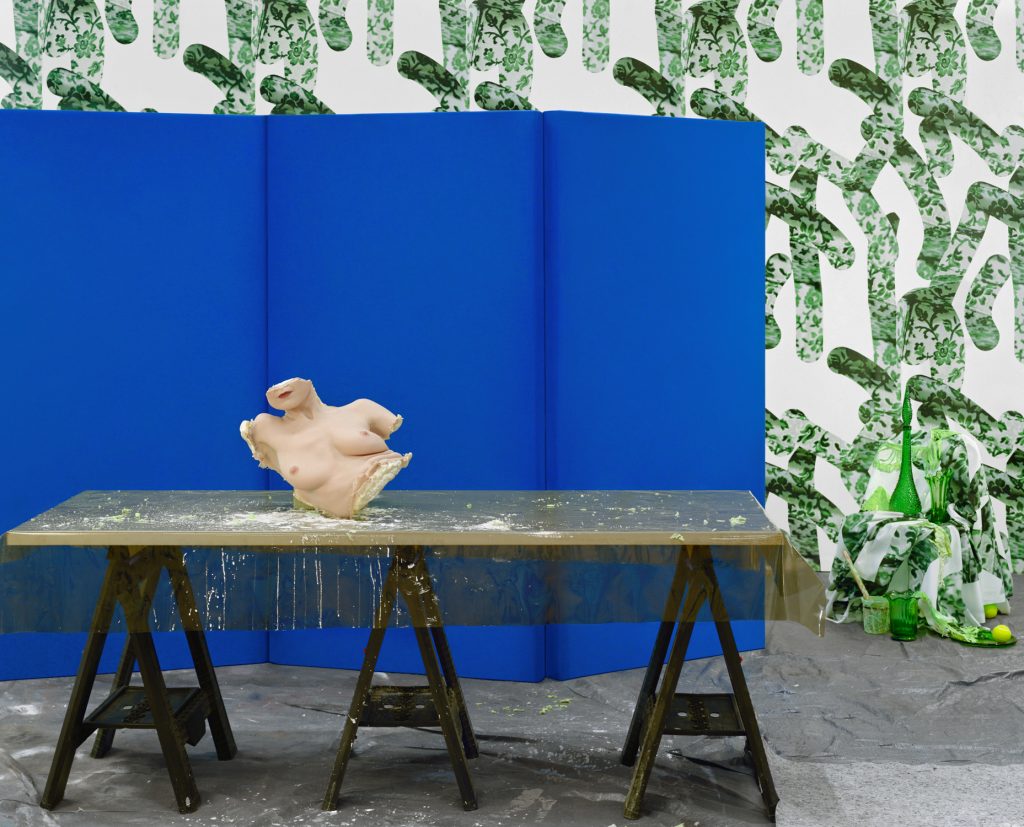
Multidisciplinary artist Ilona Szwarc‘s upcoming show Virgin Soap is filled with various shades of green and cobalt blue, with scenes of Szwarc shaping a plaster mold on a model posed in a classical position, evocative of Titian’s “Venus of Urbino.” Szwarc—whose work exists in a world between photography, sculpture and performance—tells stories of transformation in off-kilter portraits and through self-portraiture. Showing parts of her process is oftentimes an integral element of her vision. In her studio, where we visit the artist ahead of the show’s opening on 4 September, a collection of colorful mid-century glass vases sits near a small maquette of the Diane Rosenstein Gallery with a mock-up of the vibrant exhibition.
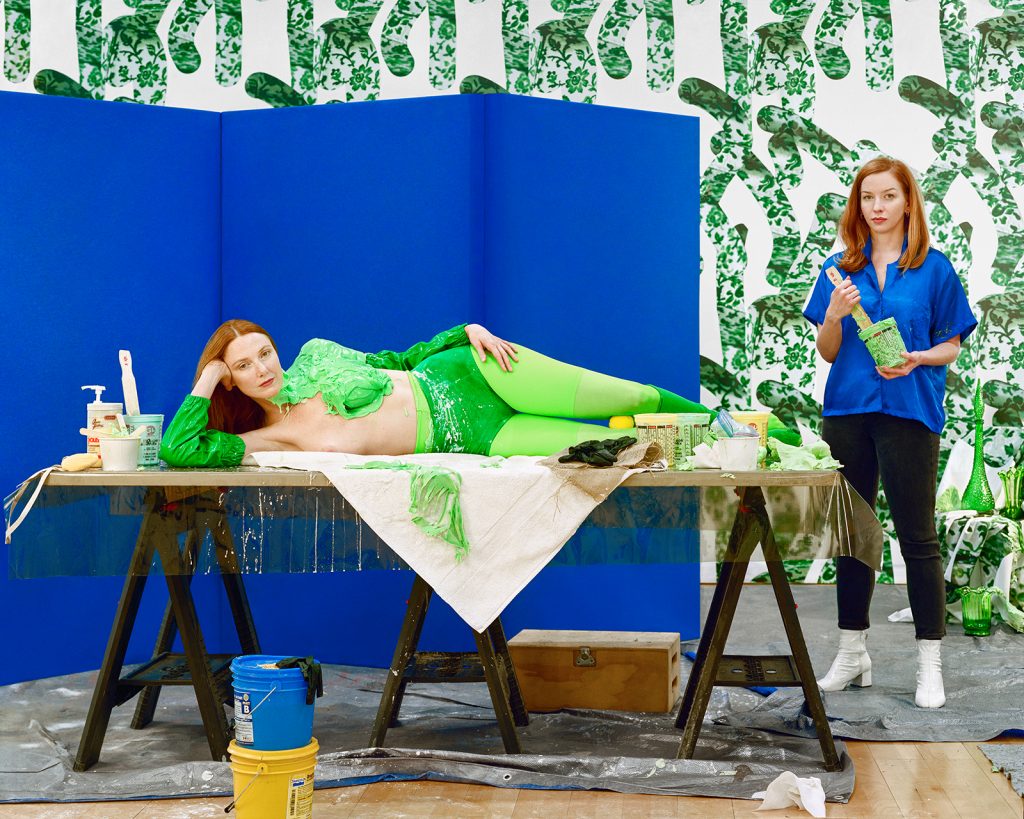
Born in Warsaw, Poland, Szwarc then moved to Canadian (a town in the Texas panhandle), where she spent her teen years. After earning her MFA at Yale, Szwarc lived in NYC, and has now been in LA for over five years. From her life in the cosmopolitan Warsaw to a small Texan town and everywhere between, Szwarc’s experience as an immigrant and her observations of the cultural differences between the various countries and cities influence her work. She also explores the lives of women and girls, the concept and reality of assimilation, and the intricacies of beauty. She has captured the power and complexities of the female experience by turning her camera toward the many worlds of girls—with dolls, rodeo animals, makeup tutorials and stories of identity, isolation and transformation.
In Virgin Soap, she focuses on Talia Shvedova, who strongly resembles Szwarc herself. Szwarc casts herself as sculptor and directs her doppelgänger in elegant poses in a setting reminiscent of classic artist studios of centuries past. The interaction, the bold color story and the peek into an artist’s world all work to reveal a fascinating cinematic story.
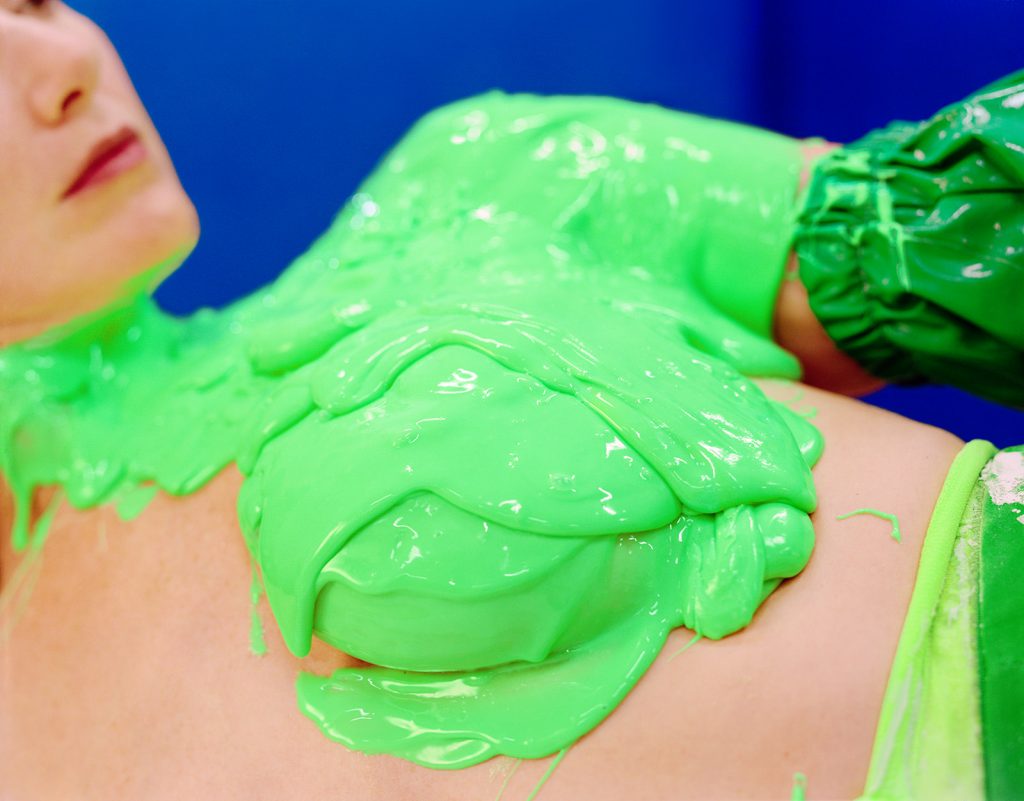
Tell us about the show’s name, Virgin Soap.
The title Virgin Soap is drawn from Charles Simic’s poem Breasts, a devotional in which Simic declares breasts to be “foam on which our hands are cleansed.” In my work, this metaphoric cleansing is both empowering and restrictive: while physically restrained by the plaster, the model challenges the camera with her gaze.
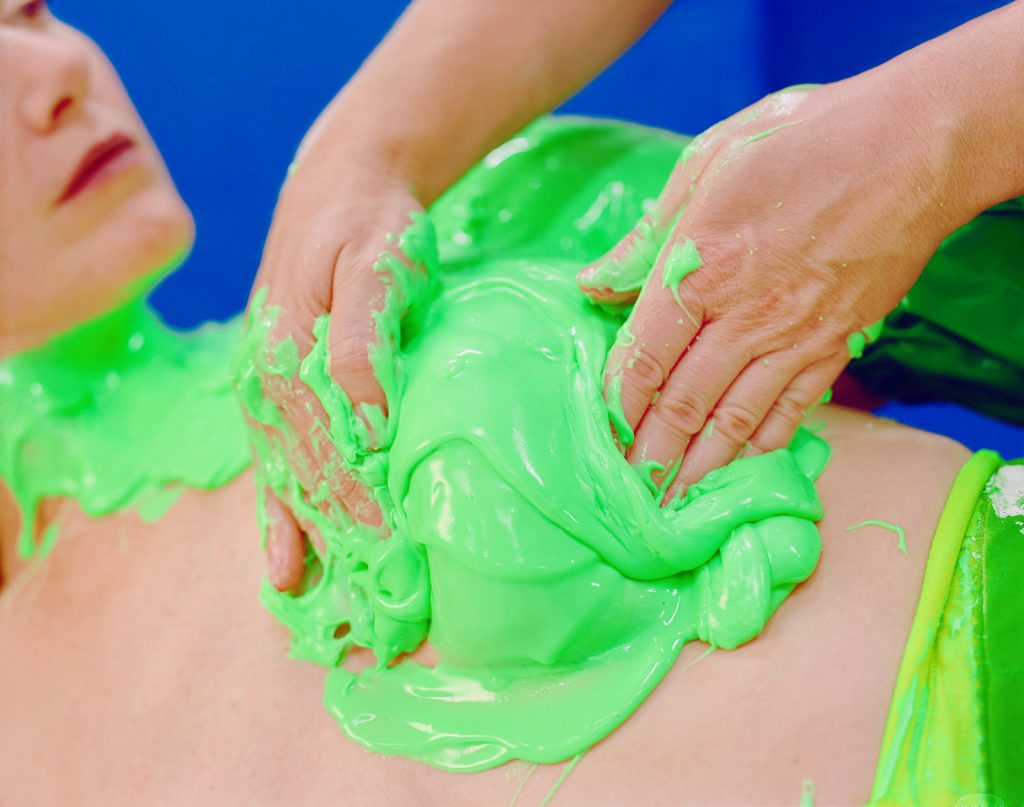
What was your initial inspiration for this body of work?
I knew I wanted to work with the neon green silicone. From there, I looked to find the right narrative to use this material in my photographs. For the past few years, I’ve been inspired by how-to aesthetics and instructional photographs and also makeup and medical illustrations, so I decided to stage this body of work as a tutorial of sorts. In the photographs, I play the role of the sculptor, and document myself casting a model’s torso in silicone and plaster.
By mimicking the persona of a male sculptor, I am reinterpreting those gestures through my female gaze, and therefore I am able to see what happens when gender roles are reversed and lines blur between passive and active bodies
How did the idea develop and transform from when you started working on this series?
While researching for this body of work, I’ve watched a lot of YouTube tutorials on how to make silicone molds and noticed a curious pattern: a lot of the tutorials were performed by men on women’s breasts. I was fascinated by the uncomfortable exchanges between the models and the sculptors. The interactions seemed stilted, but was the relationship between sculptor and model coercive? What did the models feel about being cast? What kind of touch is it? By mimicking the persona of a male sculptor, I am reinterpreting those gestures through my female gaze, and therefore I am able to see what happens when gender roles are reversed and lines blur between passive and active bodies.

How did you find Talia Shvedova, your model for Virgin Soap? Why did you choose to work with her for the project?
I’ve collaborated with Talia Shvedova, who is a Russian immigrant, and to whom I felt drawn because of our shared experience of immigrating to the US and now living in Los Angeles. I met Talia through another friend and collaborator, Sarah Mitchell, who I photographed for I am a woman and I feast on memory. My work often dwells on troubling the boundary between portrait and self-portrait. In a number of my recent projects, I have hired models nearly identical to myself—body doubles or doppelgängers—applying silicone molds and special-effects makeup to reshape them. Through these choices, I treat myself as an object and a subject at the same time—as well as the beholder of the gaze. I thought it was important that all the transformative gestures were performed on someone who looks somewhat like me and on whom I could easily project my consciousness.

Can you talk about your process of bringing this vision to life?
Once I had picked the narrative of staging and documenting the process of making a silicone torso, I started conceptualizing the space my characters would inhabit. For inspiration, I’ve looked at photographs of Matisse’s studio. There was always a pattern, a room divider, a still life and a naked woman in his studio, so I decided to go with those elements. I began with creating the pattern for the wallpaper and choosing the color scheme. I decided to narrow down the color palette to two colors: green and blue. I went with all different shades of green and the deep, cobalt blue. Both blue and green are colors used for green and blue screens, so I felt like those were fitting choices for the photographic series that takes up some of Hollywood’s tricks with special effects, props and makeup.
What camera and equipment did you use for Virgin Soap?
Virgin Soap was photographed with a TOYO FIELD 45A II Large Format Camera, using 4×5 negative film. The film is then processed and scanned on a drum scan and from those files I make inkjet prints. I first research and very carefully plan my shoots and then work with a crew of people who help me bring my vision to life during shoot days. I have my assistants stand in for me while I set up the frame and operate the camera, and then when everything is ready, I switch with them and they end up pressing the shutter.
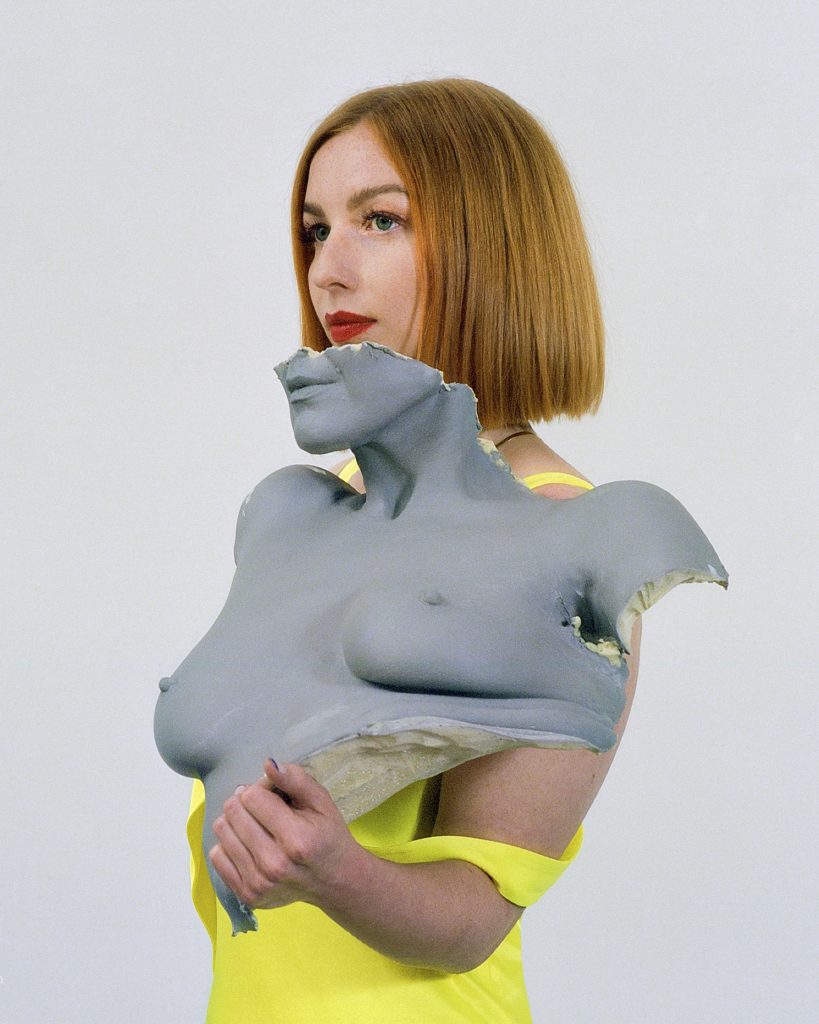
How are sculptural elements of the show integral to your overall vision?
To me, the silicone sculpture operates as an image, not unlike photography. Just like my photographs, it is created in a two-step process involving a negative and a positive. It is indexical, it is a direct representation of life and it is reproducible. To make multiples of this object, we had to cast the original torso that was created during the photoshoot, which presented me with an opportunity to create more images of that process. I looked at the different materials used up-close, and created textural, vibrant, abstracted still lives. For some of those, I turned to the panoramic format. Since a lot of the work is sequential and installed close together, the panoramas mimic that long format.
Some of the props first appeared in your project, Unsex me here. In what ways does Virgin Soap relate to your earlier works?
I began with making the wallpaper, which was installed in my studio for that shoot, and which I will also present in the gallery. I sourced the pattern from a photograph from my Unsex me here series. The wallpaper balances the digital and analog space, photography and mark-making. The pattern was created in Photoshop with digital paint strokes, but the image is still photographic. The green pattern goes in and out of focus, and has light and shadow details.
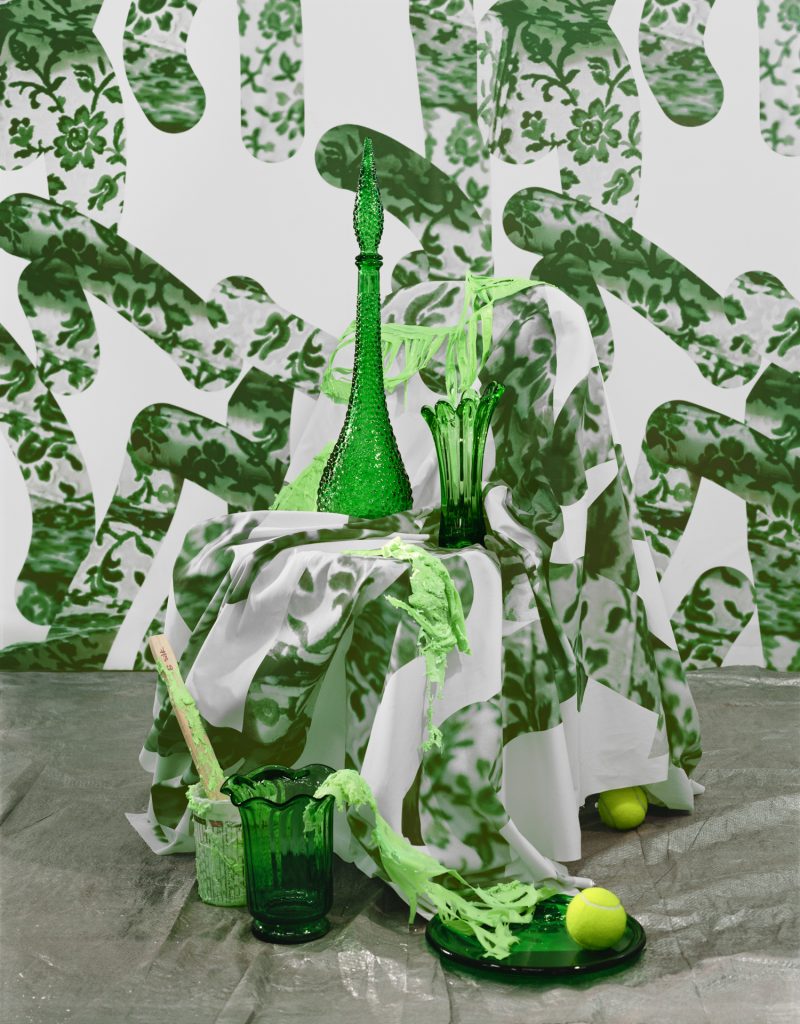
In Virgin Soap I’ve also arranged a still life with some of the mid-century green glassware I used in Unsex me here. Although in different projects I take different aesthetic paths, I think of all my work as one continuous inquiry.
In that sense, I am invested in world-building. I like to bring out traces from past work into the new work. I’ve started to work with green in Unsex me here and I wanted to explore that color palette further.
How do you choose the framing and presentation of your work? What is your process for planning the installation at the gallery?
For framing, I decided to go with a blue custom painted frame. The color of the frames matches the blue in the prints. I love how formally it adds to the photographs, bringing out another line that at once merges with the image and stands out from the image. The planning of the installation took several months. It begins with editing decisions, choosing the right amount of photographs to tell the story. I work with sequences of photographs. I have triptychs and a sequence of seven photographs in this show. I first began by making test prints, choosing the right size and determining installation ideas by trying them out in my studio. From there, I moved on to making a physical maquette of the space and printing out my images in scale and maneuvering them in the space. Lastly, I also created a SketchUp model and refined my vision for the installation from there. Every decision had to underscore the conceptual aspect of the project.
Hero image “I am on display” (2021) © Ilona Szwarc + Diane Rosenstein Gallery












